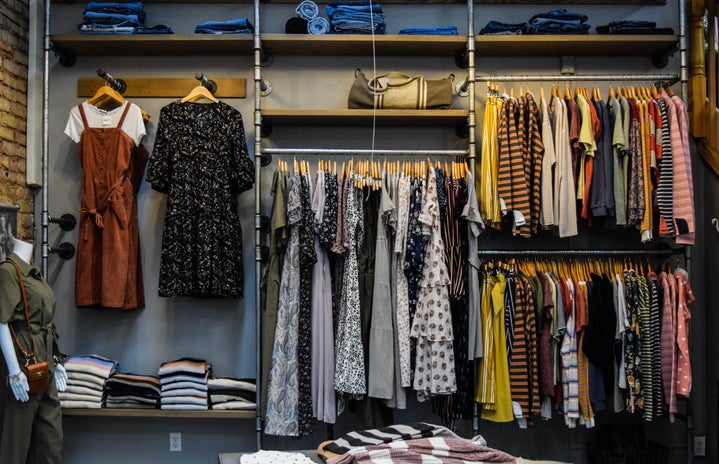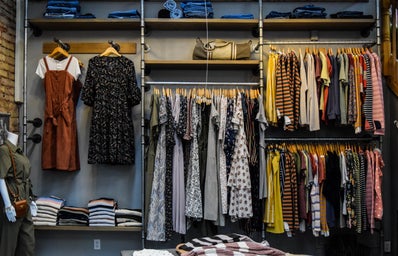With the rising threat of climate change and growing interest in sustainability, it’s more important than ever to start making personal changes in the way we impact the environment. It’s becoming more and more common to see friends, family and peers walking around with metal straws, shopping with reusable grocery bags, learning the proper recycling products and reaching for more eco-friendly options at the store. However, one seriously overlooked contributor to landfills and emissions is right under our noses: clothing.
Namely, the issue with our clothing consumption is our tendency to buy into “fast fashion.” Fast fashion is defined as clothing that imitates celebrities and runway fashion as a cheaper, lower-quality alternative. The “fast” part comes from the incredible speed at which these clothes are designed, created and put into stores for retail. Some popular fast fashion chains are Forever 21, H&M (the oldest fast-fashion retailer), Zara, Topshop, GAP, Fashion Nova, etc. These stores, though beloved amongst young adults and teens (and especially those of us who live by the “ballin’ on a budget” mentality), are some of the worst both ethically and for our environment.
Fast fashion came about at the beginning of the industrial revolution when new sewing machines were created that made it easier than ever to mass-produce clothing. This only grew more appealing to clothing manufacturers when they found they could exploit cheap labor in poor working conditions overseas. Today, more than 97% of clothing and 98% of footwear sold on American soil are manufactured internationally. This is a startling number, especially when looked at from a human rights and ethics standpoint.
But while many Americans have some awareness of the ethical issues with clothing production, many yet are still unaware of the environmental cost of such an industry. For instance, clothing production takes a lot of water. It can take literal tons of water to dye one ton of fabrics, and cotton, though seen as one of the better materials for fabric, needs a lot of water to grow. And after the water has been used and contaminated, many factories dispose of it straight into rivers and other freshwater bodies, thereby polluting our freshwater with toxic chemicals. And polyester, which is the most common synthetic fiber used in our clothing today, sheds microfibers in our washing machines that add to the percentage of plastic in the ocean. So even we, the consumers, directly add to pollution. Plus, it’s pretty gross when the fish we eat have eaten those same shed microfibers (need I say more?).
Synthetic fibers used in fast fashion to cut costs have a major impact on the earth. These fibers are non-biodegradable, taking up to 200 years to break down, and as a result, clothing is being dumped into landfills at a rate too fast to keep controlled. Approximately 3.8 billion pounds of American clothing ends up in landfills annually.
So now that you’ve gotten the basics down on what fast fashion is and why it’s harmful, here are some tips on what you can do about it:
-
Treat yourself: Yes, it’s okay to buy that designer jacket you’ve wanted. Though you’re almost certainly shelling out more money than a garment is worth when you buy designer, this can be a great alternative to fast fashion for three reasons: 1. You’re buying better quality garments, which means that they will last you much longer; 2. You’re buying clothing that you’ll want to cherish and treat well. Gucci doesn’t often go to the landfill; and 3. You’re less likely to spend frivolously when you’re making purchases that seriously put a dent in your wallet. No one buys a $300 dollar shirt before really making sure they want it.
-
Marie Kondo the hell out of everything you purchase before you purchase it: You know that Marie Kondo meme about what does and doesn’t spark joy? Well, I think she’s onto something there. When you go shopping, make sure that you really want the garment that you’re buying. A way to do this is by considering a few things: do I feel confident in this garment? Will I wear it often? Does it fit my style? Is it something that I can wear for a long time? Will it make it through more than a couple of washes? Putting real consideration into your purchases can prevent you from buying something you’ll want to throw away. It can also help to make a list of things you want to buy before you go shopping so that you keep your eyes on the prize in-store. And waiting a while to make sure you still want the items on your list can help from making impulse purchases. It’s a win-win-win for the earth, your wallet and your closet space.
-
Go thrifting: I seriously swear by this tip; in fact, a huge chunk of my closet holds thrifted items, and I’m never sporting an outfit without at least one thrifted garment. Not only is thrifting really fun to do with your friends, but it’s also a great way to broaden your style without contributing to fast fashion or breaking the bank. It’s really easy to find cute current clothing at the thrift store, as well as cool vintage pieces or secret designer finds.
-
Upcycle: If you’ve got old clothes that don’t fit, have holes or just aren’t doing it for you anymore, then one alternative to just throwing them away is finding ways to upcycle them. Sometimes a little bit of sewing can save an otherwise intact garment. And finding cool ways to use up the old clothes you’ve got and make them new again can be really fun. This can include making patches for a jacket, DIY reusable makeup remover pads and pillows from a nostalgic t-shirt.
-
Try to sell or give your clothes away to people that really want them BEFORE donating: Donating is really great, but it isn’t perfect. About 80% of donated clothing ends up overseas and is sold to low-income citizens. While this seems beneficial at first glance, the mass amount of secondhand clothing can impact local clothing markets and traditions, and many countries are pushing back against the massive amounts of secondhand clothing coming into their possession. This means that more and more donated clothing could just end up in landfills anyway. So make a Poshmark or Depop and get selling! You can start a small side-hustle while re-homing clothing without the middleman. And if your friend has always had heart-eyes looking at that skirt you don’t want anymore, give it to them!
-
Donate! But do your research: Of course, donating is still great practice, and it goes on to help many people with little money and helps provide jobs. But do your research on where your clothing is going and what sort of organizations you’re supporting by donating to them.
-
Try to never throw away clothing, find your local fabric recycling bin: When all else fails, avoid simply throwing your old unwanted clothes in the dumpster. Instead, search the internet for local textile recycling bins and facilities. H&M has a great new sustainability initiative where you bring a bag of any and all fabric waste you want to get rid of and in return get a discount on your next purchase. These garments, in turn, are sent to local recycling facilities to be hand-sorted. This can be a great way to recycle your garments, and it’s so easy! The discount is also a great incentive to get your friends involved as well.
Single-handedly taking on the fight against global warming can seem daunting, but practicing sustainable living in small ways could build up to a huge impact. Encourage those around you to make more conscious fashion choices. It’s the least we can do.
Follow HCND on Twitter, like us on Facebook, Pin with us and show our Instagram some love!


